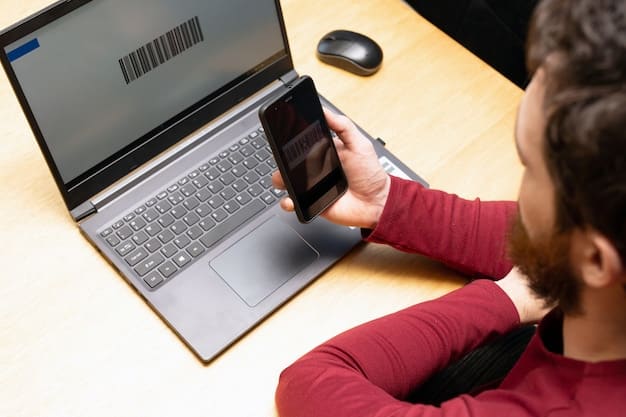Protect Yourself: 5 Steps to Avoid Identity Theft

Protecting yourself from identity theft involves understanding potential threats and implementing proactive measures such as monitoring your credit report, securing your online accounts, and being cautious with your personal information.
In today’s digital age, how to protect yourself from identity theft: 5 steps to safeguard your personal information is a vital concern for everyone. The rise of online transactions and data breaches has made personal information more vulnerable than ever. By taking proactive steps, you can significantly reduce your risk and protect your financial well-being.
Understand the Risks of Identity Theft
Identity theft occurs when someone uses your personal information, such as your Social Security number, credit card details, or other identifying data, without your permission. This can lead to financial losses, damaged credit scores, and a host of other problems.
Common Types of Identity Theft
There are several ways identity thieves can obtain your information. It’s important to be aware of these methods to better protect yourself.
- Phishing: Fraudsters send emails or text messages disguised as legitimate communications to trick you into providing sensitive information.
- Data Breaches: Companies that store your personal data can experience security breaches, exposing your information to hackers.
- Skimming: Criminals use devices to steal your credit or debit card information when you swipe your card at ATMs or point-of-sale terminals.
The Impact of Identity Theft
The consequences of identity theft can be severe and long-lasting. Victims may face:
- Financial Losses: Thieves can make unauthorized purchases, open fraudulent accounts, and drain your bank accounts.
- Credit Damage: Unpaid bills and fraudulent credit card accounts can negatively impact your credit score, making it difficult to obtain loans or credit in the future.
- Emotional Distress: Dealing with the aftermath of identity theft can be time-consuming and emotionally draining.
Staying informed about the risks and potential impacts of identity theft is the first crucial step in safeguarding your personal information. Recognizing the various methods used by identity thieves empowers you to take proactive measures and minimize your vulnerability.
Monitor Your Credit Report Regularly
One of the most effective ways to detect and prevent identity theft is to monitor your credit report regularly. Errors or suspicious activity on your report can be early warning signs of identity theft.
How to Access Your Credit Report
You are entitled to a free copy of your credit report from each of the three major credit bureaus (Equifax, Experian, and TransUnion) once every 12 months. You can request your reports at AnnualCreditReport.com.
What to Look for in Your Credit Report
When reviewing your credit report, pay close attention to the following:
- Inaccurate Personal Information: Verify that your name, address, and Social Security number are correct.
- Unauthorized Accounts: Look for accounts that you did not open or do not recognize.
- Suspicious Activity: Check for inquiries or transactions that you did not authorize.
Regularly monitoring your credit report allows you to identify and address any fraudulent activity promptly. By detecting errors or suspicious entries early, you can minimize the potential damage caused by identity theft. Consistent vigilance is key to maintaining a healthy credit profile and protecting your financial identity.

Secure Your Online Accounts
In today’s digital world, securing your online accounts is paramount to preventing identity theft. Weak passwords and lax security practices can leave your accounts vulnerable to hackers.
Use Strong, Unique Passwords
Create strong, unique passwords for each of your online accounts. A strong password should:
- Be at least 12 characters long
- Include a mix of upper and lower case letters, numbers, and symbols
- Not be easily guessed or related to your personal information (e.g., birthday, pet’s name)
Enable Two-Factor Authentication
Two-factor authentication (2FA) adds an extra layer of security to your accounts. When 2FA is enabled, you will need to provide a second form of verification, such as a code sent to your phone, in addition to your password.
Implementing strong passwords and enabling two-factor authentication on your online accounts significantly reduces the risk of unauthorized access. These simple yet effective security measures can safeguard your personal information and protect you from potential identity theft.

Be Cautious with Your Personal Information
One of the primary ways identity thieves obtain information is by tricking people into divulging it. Being cautious with your personal information can significantly reduce your vulnerability.
Avoid Sharing Sensitive Information Online
Be wary of unsolicited emails, text messages, or phone calls that ask for your personal information. Legitimate organizations will typically not request sensitive data through these channels.
Secure Your Physical Documents
Shred documents that contain personal information before disposing of them. This includes bank statements, credit card bills, and any other documents with your name, address, or financial details.
Being vigilant about protecting your personal information, both online and offline, is crucial in preventing identity theft. By exercising caution and implementing these security measures, you can significantly reduce the risk of falling victim to fraud.
Place a Fraud Alert or Security Freeze
If you believe your personal information has been compromised, consider placing a fraud alert or security freeze on your credit report. These measures can help prevent identity thieves from opening new accounts in your name.
Fraud Alerts
A fraud alert is a notice placed on your credit report that alerts creditors to verify your identity before approving any new credit applications. There are two types of fraud alerts:
- Initial Fraud Alert: Remains on your credit report for one year.
- Extended Fraud Alert: Remains on your credit report for seven years and requires you to file a police report.
Security Freeze
A security freeze, also known as a credit freeze, restricts access to your credit report. This prevents new creditors from viewing your credit history, making it more difficult for identity thieves to open fraudulent accounts.
Placing a fraud alert or security freeze can provide an additional layer of protection against identity theft. These measures empower you to control who has access to your credit information and can help prevent unauthorized accounts from being opened in your name.
Review Your Bank and Credit Card Statements Regularly
Regularly reviewing your bank and credit card statements is an essential step in detecting and preventing identity theft. By scrutinizing your financial transactions, you can quickly identify any unauthorized or suspicious activity.
What to Look for in Your Statements
When reviewing your statements, pay close attention to:
- Unrecognized Transactions: Look for any purchases or withdrawals that you did not authorize.
- Small, Recurring Charges: Scammers sometimes test stolen credit card numbers with small charges before making larger purchases.
- Unfamiliar Payees: Check for any payments to companies or individuals that you do not recognize.
Regularly reviewing your statements enables you to catch fraudulent activity early and minimize potential financial losses. By taking the time to scrutinize your transactions, you can protect yourself from identity theft and maintain control over your financial health.
| Key Point | Brief Description |
|---|---|
| 🛡️ Monitor Credit | Check credit reports regularly for suspicious activity. |
| 🔒 Secure Accounts | Use strong passwords and enable two-factor authentication. |
| 🗑️ Shred Documents | Shred sensitive documents before throwing them away. |
| 🚨 Fraud Alert | Place a fraud alert or security freeze if compromised. |
Frequently Asked Questions
▼
Identity theft occurs when someone uses your personal information, like your name, Social Security number, or credit card details, without your permission to commit fraud or other crimes.
▼
Signs include unauthorized transactions on your bank statements, unfamiliar accounts on your credit report, and receiving bills for services or products you didn’t order.
▼
Immediately contact your bank and credit card companies to report the fraud. Place fraud alerts on your credit reports and file a report with the Federal Trade Commission (FTC).
▼
A security freeze restricts access to your credit report, preventing new creditors from viewing it. This makes it harder for identity thieves to open new accounts in your name.
▼
You should check your credit report at least once a year. You’re entitled to a free copy from each of the three major credit bureaus annually at AnnualCreditReport.com.
Conclusion
Protecting yourself from identity theft requires a proactive and vigilant approach. By monitoring your credit report, securing your online accounts, being cautious with your personal information, placing fraud alerts or security freezes, and regularly reviewing your financial statements, you can significantly reduce your risk and safeguard your financial well-being.





